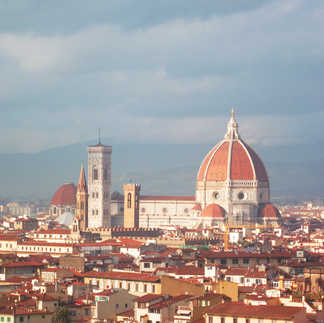
The Cathedral of Santa Maria del Fiore, located in the heart of Florence, is one of the city's most iconic landmarks. Its construction began in 1296 under the direction of Arnolfo di Cambio and took nearly 140 years to complete. This cathedral is not only a testament to the Florentines' religious devotion but also a masterpiece of Gothic and Renaissance architecture. The enormous dome, designed by Filippo Brunelleschi, remains an impressive feat of engineering even centuries after its construction.
The cathedral, often referred to as the Florence Duomo, is famous for its multicolored marble facade, which combines white, green, and red. However, this facade was only completed in the 19th century in a Neo-Gothic style by Emilio De Fabris. The adjacent bell tower, designed by Giotto, adds another dimension to the cathedral's impressive silhouette. Climbing the 414 steps of the tower offers breathtaking panoramic views of Florence.
The interior of the cathedral, while more austere compared to the elaborate facade, has a sense of grandeur and vastness. The marble floor is a work of art in itself, with complex geometric patterns. Brunelleschi's dome, with its frescoes by Giorgio Vasari and Federico Zuccari depicting the Last Judgment, is one of the most impressive features. These frescoes are a spectacular fusion of art and spirituality, prompting visitors to reflect on profound themes while admiring the artistic beauty.
To visit the Cathedral of Santa Maria del Fiore, visitors typically start at Piazza del Duomo, the vibrant center of Florence. Tickets to visit the interior of the cathedral, climb the dome, the bell tower, and the baptistery can be purchased online or at the ticket office located in the piazza. It is recommended to buy tickets in advance, especially during the high season, to avoid long lines.
Brunelleschi's dome is a highlight of the visit. The climb up the narrow, spiral staircase to the top of the dome can be challenging, but the panoramic view of the city is worth every step. This unique perspective allows visitors to appreciate the Renaissance layout of Florence, with its narrow streets, historic palaces, and the Arno River running through the city. The climb also offers a close-up view of the Last Judgment frescoes, providing an unforgettable experience.
Besides the Duomo, the complex includes the Baptistery of St. John, famous for its magnificently sculpted bronze doors known as the "Gates of Paradise," a work by Lorenzo Ghiberti. The baptistery is one of the oldest buildings in Florence, dating back to the 11th century, and is an excellent example of Romanesque architecture. Its interior is equally fascinating, with mosaics covering the dome depicting biblical scenes with impressive detail.
The Museo dell'Opera del Duomo, located behind the cathedral, is another must-see. This museum houses an extraordinary collection of art and sculpture related to the cathedral, including works by Michelangelo, Donatello, and other Renaissance masters. One of the museum's most notable pieces is one of Michelangelo's Pietàs, which the artist originally planned for his own tomb. The museum also displays models and tools used in the cathedral's construction, providing an in-depth look at the monumental effort required to build this masterpiece.
The importance of the Cathedral of Santa Maria del Fiore to Florence cannot be overstated. It is not only a symbol of religious faith but also a testament to the city's power and wealth during the Renaissance. The construction of Brunelleschi's dome, in particular, symbolizes the innovative spirit and determination of the Florentines, marking a turning point in architectural history. The cathedral has served as the backdrop for many significant events in the city's history, from religious processions to civic celebrations.
Visiting the Cathedral of Santa Maria del Fiore is an experience that goes beyond mere aesthetic appreciation. It is a deep dive into Florence's history, where every stone, every artwork tells a part of the city's rich cultural tapestry. To make the most of the visit, it is advisable to take a guided tour, which can provide detailed insights into the Duomo's history, art, and architecture.
The cathedral is open to the public daily, but hours may vary, especially during religious holidays. Entry to the cathedral is free, but a ticket is required to climb the dome, the bell tower, the baptistery, and to visit the museum. For history and architecture enthusiasts, a guided tour can further enrich the experience, providing a deeper understanding of the innovative techniques used in the construction and the stories behind the artworks.
The best time to visit Florence and the Cathedral of Santa Maria del Fiore is in the spring or fall when the weather is mild and the crowds are smaller compared to the peak summer months. Regardless of the time of year, however, the cathedral remains one of Florence's most popular attractions, drawing millions of visitors from around the world. Each visit offers a new perspective, and the immense legacy of the Duomo continues to inspire awe and reverence.
-(02_2).png)












Comments